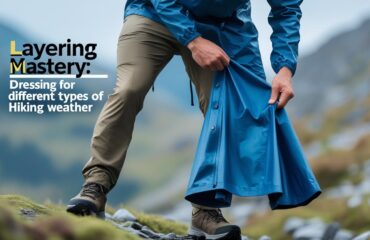
Download our FREE Hiking and Backpacking Apparel Packing Checklist
Importance of Choosing the Right Hiking Apparel
Selecting appropriate clothing for hiking is vital to ensure comfort and safety while navigating the trails. The right hiking apparel acts as a barrier against the elements, helping to regulate body temperature and prevent injuries from chafing or hypothermia. A well-thought-out outfit can significantly enhance your overall hiking experience, allowing you to enjoy the journey rather than focus on discomfort. For instance, wearing moisture-wicking fabrics can keep you dry and comfortable, while the wrong attire can lead to a frustrating outing.
This article will provide a comprehensive hiking apparel checklist, covering everything from head to toe. Understanding the local weather forecast and trail conditions is crucial for making informed clothing decisions. For example, if you anticipate rain, a waterproof jacket will be essential to keep you dry, while sunny conditions may necessitate breathable fabrics and sun protection.
Layering Basics
Layering is essential for hiking apparel, as it allows you to adjust your clothing according to changing weather conditions and your activity level. A base layer is the first line of defense, ideally made from moisture-wicking materials like merino wool or synthetic fabrics, which keep your skin dry by drawing sweat away. For instance, wearing a lightweight merino wool shirt can help you remain comfortable and dry on a warm day.
The mid-layer, such as a fleece or an insulated jacket, provides warmth and should be lightweight for easy packing. An outer layer should be waterproof and breathable to shield you from rain and wind while allowing moisture to escape. This combination of layers not only helps regulate your body temperature but also enables quick adjustments during varying activity levels. For example, if you start to feel too warm while hiking uphill, you can easily remove your mid-layer without having to change your entire outfit. It’s important to have essential hiking gear to ensure safety on the trails.
Recommended Materials for Hiking Clothing
When selecting hiking clothing, it’s essential to choose materials that enhance comfort and performance. Moisture-wicking fabrics, such as polyester and nylon, are excellent choices as they facilitate sweat evaporation, keeping you dry during strenuous activities. Merino wool is another recommended material for base layers due to its natural odor resistance and comfort. Avoid cotton and denim, as they retain moisture and can lead to discomfort on the trail.
Additionally, consider breathable fabrics with UPF (Ultraviolet Protection Factor) ratings to protect against harmful sun exposure. Opting for environmentally friendly materials, such as those certified by bluesign®, shows a commitment to sustainability while ensuring quality. For instance, wearing a lightweight, UPF-rated shirt can protect your skin from sunburn while promoting airflow during a hike.
Essential Hiking Gear for Different Weather Conditions
Hiking in varying weather conditions requires specific gear to ensure safety and comfort. For rainy weather, a reliable waterproof jacket and pants are crucial, ideally featuring ventilation zippers for breathability. In contrast, cold weather hikes necessitate insulation layers, such as down or synthetic jackets, to retain warmth. For example, wearing a down jacket over your base layer can provide significant warmth during chilly hikes.
Hot weather requires lightweight and breathable fabrics to prevent overheating. In winter conditions, thermal base layers and windproof outer shells are essential to keep you warm during frigid temperatures. Always pack a backup layer of clothing in case of unexpected weather changes; this can be the difference between a joyful hike and a miserable experience.
Footwear Recommendations
Choosing the right footwear is crucial for a successful hiking experience. Hiking boots should provide ample support and traction, with waterproof options being ideal for wet conditions. For less rugged terrains, trail-running shoes can be a comfortable alternative, offering agility and lightweight support. For instance, wearing a good pair of waterproof hiking boots can prevent blisters and keep your feet dry during a muddy hike.
Additionally, using moisture-wicking socks is essential to prevent blisters and enhance comfort during long hikes. Look for shoes with rubberized toe caps to protect your feet from rocks and other trail debris. Breaking in new footwear before embarking on long hikes is also important to avoid discomfort and blisters.
Accessories for Enhanced Comfort and Safety
Accessories play a crucial role in enhancing comfort and safety while hiking. Wearing hats and sunglasses provides essential sun protection, and a wide-brimmed hat offers the best coverage. Gaiters can be beneficial for keeping debris and moisture out of your boots on muddy or snowy trails. For example, using gaiters can prevent dirt and gravel from entering your boots, making your hike more enjoyable.
A well-fitted daypack is necessary for carrying essentials, such as food, water, and first aid supplies. Including trekking poles can help with stability and reduce strain on your knees during descents. Additionally, carrying a multi-tool or utility knife can provide versatility in various situations on the trail.
Packing Efficiently for a Hiking Trip
Efficient packing is essential for a successful hiking trip. Start by creating a checklist that includes all clothing layers, footwear, and essential gear to ensure you do not forget anything. Pack your clothing in a way that allows easy access to different layers, especially with changing weather conditions. For example, placing your rain jacket on top of your pack can make it readily accessible during unexpected downpours.
Including a lightweight emergency kit with a headlamp, first aid supplies, and a map is crucial for safety. Using compression bags for clothing can save space and keep your gear organized. Planning meals and snacks ahead of time, ensuring they are lightweight and easy to pack, can contribute to a more enjoyable hiking experience.
A well-thought-out hiking apparel checklist is vital for a successful hiking experience. By considering specific hiking conditions and personal comfort, you can select the best clothing to enhance your adventure. Investing in quality gear is significant for safety and enjoyment on the trail. As you gain experience, remember to periodically review and update your gear to meet your evolving needs.
Hiking Apparel Checklist (Layered + Weather + Duration-Based)
Headwear
- Sun Hat / Brimmed Hat – Hot/sunny weather
- Wool or Fleece Beanie – Cold weather and evenings
- Buff / Neck Gaiter – Versatile for sun, wind, cold, and dust
- Rain Hood or Waterproof Hat – Wet conditions
- (Multi-day: Bring 1–2 depending on forecast)
Base Layer (Next to Skin)
- Moisture-wicking T-Shirts (Synthetic or Merino Wool) – Regulates body temp
- Hot weather: Short-sleeve or tank top
- Cold weather: Long-sleeve thermal base layer
- (1 per day or 2–3 rotating for 3+ day trips)
Mid Layer (Insulation)
- Fleece Jacket or Pullover – Lightweight, breathable warmth
- Synthetic or Down Puffy Jacket – For cold mornings/evenings
- (Bring 1 for all-weather protection on multi-day trips)
Outer Layer (Weather Protection)
- Waterproof Rain Jacket (with ventilation) – Essential for rain, wind, or variable conditions
- Rain Pants – Especially for wet and cold terrain
- Windbreaker (optional) – For high-altitude or breezy days
- (1 each per trip – lightweight but crucial layers)
Bottoms
- Quick-dry Hiking Pants – Durable and protective
- Convertible Pants (Zip-Off) – Great for hot-to-cool transitions
- Hiking Shorts – Hot weather or desert hiking
- Thermal Bottoms / Base Layer Leggings – Cold weather
- Rain Pants (Shell Layer) – For wet weather
- (1–2 pairs depending on duration and forecast)
Socks
- Merino Wool or Synthetic Hiking Socks – Moisture-wicking and blister-resistant
- Sock Liners – Optional for extra blister protection
- (1 pair per day or 2–3 pairs rotating with drying time)
Gloves
- Lightweight Gloves (Fleece or Synthetic) – For cold mornings
- Waterproof Shell Gloves – For rain or snow
- (1 pair of each in cold or wet weather conditions)
Footwear
- Hiking Boots (Mid or High-Cut) – For rugged or rocky terrain
- Trail Running Shoes / Lightweight Hiking Shoes – For well-maintained trails or hot conditions
- Camp Shoes (Sandals or Foam Slides) – Optional but great for multi-day comfort
- (1 sturdy pair + 1 camp pair for multi-day hikes)
Undergarments
- Moisture-wicking Underwear (Synthetic or Merino) – Avoid cotton
- Sports Bra (for women) – Supportive and quick-drying
- (1 per day or 2–3 pairs rotated for longer trips)
Sleepwear (for Multi-Day Trips)
- Comfortable, Clean Base Layer (Top and Bottom) – Keep separate from daywear
- Wool Socks – For sleeping in cold conditions
- Extra Beanie – Prevents heat loss at night
Adjustments by Terrain
- High Altitude – Extra insulation + wind protection
- Wet/Marshy Areas – Extra socks + waterproof layers
- Desert/Dry – UV-protective, breathable layers + hat
- Dense Forest / Tick-prone Areas – Long sleeves and pants
Optional Accessories
- Gaiters – For snow, sand, or rocky terrain
- UV-Protective Sleeves – For intense sun exposure
- Bug-Net Hat – For mosquito-heavy zones


